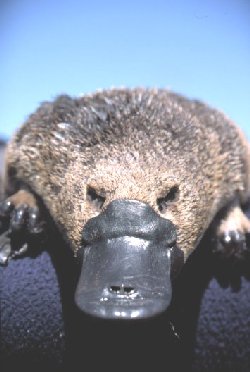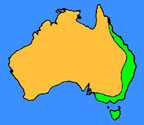
Photo courtesy of http://www.healthsci.utas.edu.au/physiol/mono/Platpage.html
|
(Orinthorhynchus anatinus) |
| Platypus Facts | 
Photo courtesy of http://www.healthsci.utas.edu.au/physiol/mono/Platpage.html |
| The Australian platypus (Orinthorhynchus anatinus) is a curious animal that inhabits the freshwater lakes, creeks, and streams of eastern Australia (Fig. 1) from the waters of the Cooktown area in the north to the icy-cold southern streams in the Tasmanian mountains (Tonkin and Negrine, 1994). Weighing between 1.8 to 2.5 kg and ranging in size from 45 to 60 cm in length, platypuses live in burrows that neighbor sources of freshwater. Venturing from their self-made burrows around dawn and dusk, platypuses opportunistically forage the water and surrounding area for worms, insects, frog larvae, and especially small crustaceans (Fenner et al., 1992; Tonkin and Negrine, 1994). |
Figure 1: Habitat (in green) of Platypus

Photo courtesy of http://www.healthsci.utas.edu.au/physiol/mono/Platpage.html |
| A peculiar amalgamation of a
paddle-like tail, webbed feet, and dense fur, the platypus, first captured
in 1797 on the Hawkesbury River, New South Wales, was first thought by
British scientists to be a whimsical duck-beaver hybrid concocted by a
creative Australian taxidermist (Fenner et al., 1992) Once proven not to
be a hoax, scientists realized that the platypus was a highly evolved animal
possessing a host of marvelous adaptive advantages for its semi-aquatic
mode of life. Although appearing to be a cute, harmless ball of fur, the
platypus can be very dangerous. Among its wide array of distinct morphological
characteristics, the adult male platypus manufactures venom that packs
a potent punch. When injected into other animals via a spur, platypus venom
produces excruciating, lasting pain powerful enough to debilitate humans
and kill dogs.
This web page provides an overview of the morhology of the platypus and a detailed discussion of the effects of platypus venom on humans at both the clinical and cellular level. |
 |